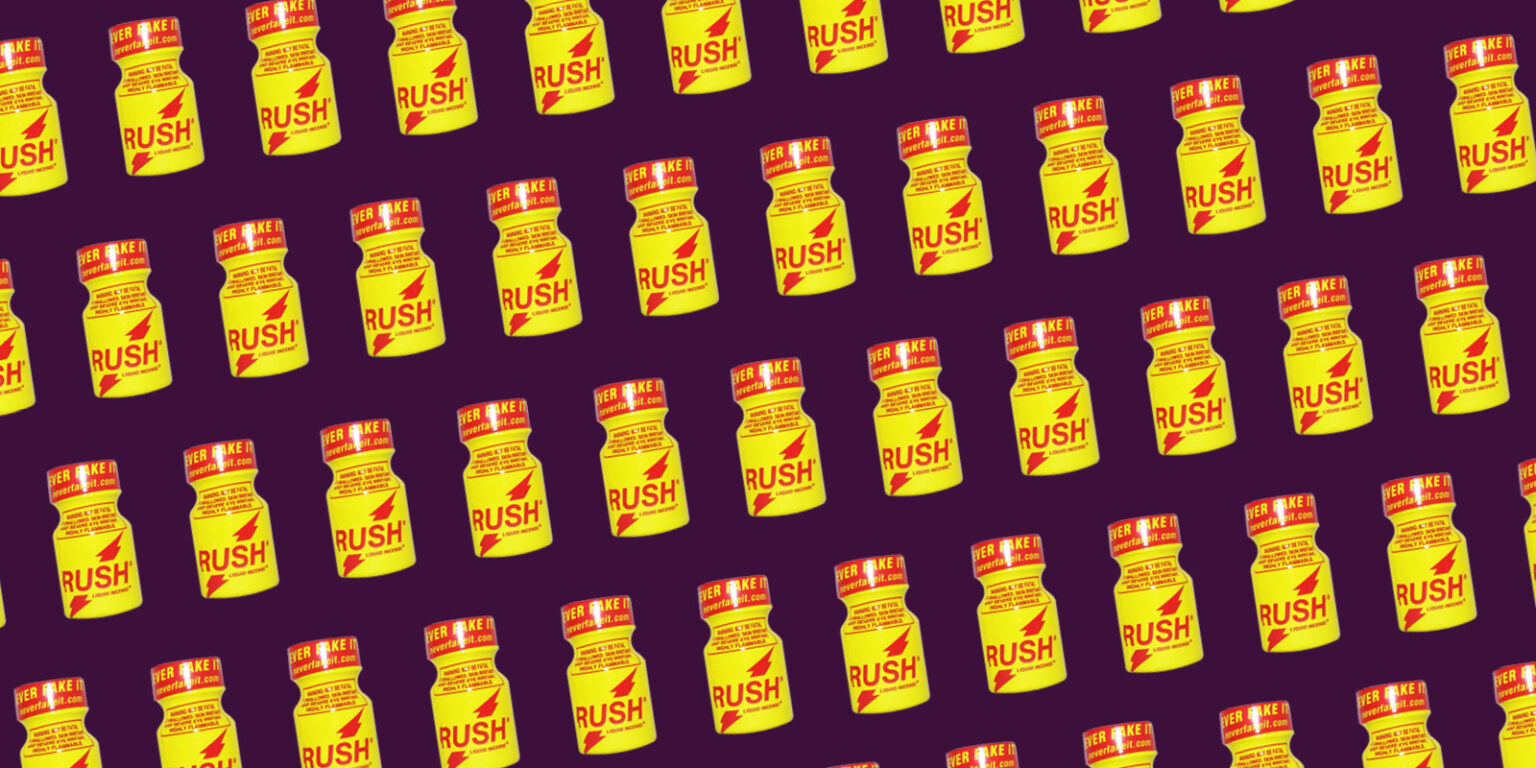“You got my heartbeat racing, my body blazing… I feel the rush, addicted to your touch”. Excitement, euphoria, lividity, sweat. Inhibition. Pop artist Troye Sivan portrays the whole maelstrom of sensations in his song “Rush”. The homoerotic character of the song dialogues with the popper subtext.
Crossed by an imposing red lightning bolt, like David Bowie’s face, and wrapped in a striking and intense yellow colour, more intense than the yellowish liquid contained in the bottle itself. 9ml for the small, 30ml for the XL, classic version, super version, gold version. Rush is the flagship brand of the popper, the trendy drug whose effect lasts as long as a Tik Tok. Open the bottle, cover it with your finger when you’re not inhaling, you’ll lose the vapour. Cover one nostril and bring the popper close to the other, but don’t overdo it, otherwise it will burn your skin. Inhale and plug again. The amyl nitrite vapour enters the body, reddens the face and produces a flare in the body like that of a match when it is lit, and then immediately extinguishes. For a few seconds, you emerge in an ecstasy, which then evaporates into nothingness.
The perfect cocktail for the culture of immediacy
Amyl nitrite, the formal name for popper, began to be marketed in pharmacies as a vasodilator treatment for angina pectoris. The narcotic effects of inhaling the liquid’s vapour soon led to other uses, and in London, uncontrolled sales led to alarm bells being sounded by the Pharmaceutical Society in the mid-1970s. At the same time, in the United States, nightlife smelled of paint thinner: Rush was gaining momentum with its marketing strategy. Advertising was targeted at gay and leather culture magazines of the time, such as Drummer magazine. It was an open secret that Popper’s buyers were gay men, but it had never been appealed to.
Under the pretext of being an “indoor air freshener” and other gimmicks in the face of angry health regulators, the popper began its passage into the annals of history.
“It increases sexual arousal and relaxes the sphincters. This is the main reason why it has been used in the gay scene since the 1970s, when it was at its peak in New York nightclubs, and later spread to raves and parties,” explains a report by the National Plan on Drugs.
Stigma towards anal sex (and consequently, towards the gay community) increased in the 1990s with the advent of HIV. Ignorance played its part, associating men who have sex with men (MSM), poppers and disease under the same criminalising spotlight: “early in the AIDS epidemic there were some studies that linked poppers to the development of Kaposi’s sarcoma (one of the most prevalent AIDS-defining cancers). However, many subsequent studies have shown that these associations are not based on sufficient evidence and have therefore been dismissed,” explains a study by the HIV Treatment Working Group.
The popper has always had a great symbolic charge around it, but nothing in sex is anyone’s patrimony: neither behaviours, nor practices, nor drug use. Regarding poppers, the report of the National Plan on Drugs points out that “it is currently also used by heterosexuals, mainly for its effects in the sexual sphere”.
Circuit de Montmeló (Circuit de Barcelona-Catalunya). 10 September 2023. The first edition of a sold-out macro-festival is held in the open air – in the same place where Verstappen won the F1 Grand Prix a few months ago.
– Smells like feet, shall we move?
– What?
– Well, like rotten paint, I don’t know, maybe we’ve stepped in shit, look at my shoes, because I’ve been smelling it all night.
– I think it’s not what you think
[The group of kids in a circle at the side breaks up].
– Hey, do you want some?
“When you make pop, there’s no stop, there’s a weight, what a fucking horror”, sings Ben Yart in his song “Popper”. The song’s refrain, nothing could be further from the truth: “They offer us Popper, they offer us Popper”. Popper adherence is like HerbaLife, whoever has, offers to whomever – euphoria makes solidarity flourish. As if Mr. Rush gives commission for generating new members to feed a pyramid scheme. The popper has the ingredients that have cooked up its democratisation: cheap (for about 8 euros you get a 10ml bottle) and accessible (you can buy it online). It also has the ingredients to have become a trend: it is the quick, instant high, with no waiting time and no prolongation, the perfect cocktail for the culture of immediacy.
A global vapour hovering over the skies as night falls
Poppers as a trend has been redefined, and the gay men who used to go to those London pharmacies in the mid-1970s are now any profile of person adding nitrite to Mr Bezos’s online shopping basket. The uses associated with chemsex have been diluted: much of the users are young people who simply want a quick fix on a night out. “You feel like your blood rushes to your brain and your temperature rises, you suddenly have a sort of euphoric high,” says A, a young popper user in a nightlife context. “At the moment it helps you to carry on with the party, but the effect is very short-lived,” he adds.
As for short-term effects, such as the next day, she does not point to any specific pattern beyond the alcohol hangover itself: “I’ve never noticed anything, although I guess it also depends on how many times you take it during the night”, she explains, adding that she knows someone who usually gets a headache. Along the same lines, another young popper user says that once she inhaled too many times, the next day she felt as if she constantly felt like she had to defecate. “People take it several times during the night because of the pleasure it gives you,” says A.
The accessibility, immediacy, and lack of ‘consequences‘ – unlike, for example, the characteristic ‘comedown’ associated with crystal meth or cocaine – make it easier to perceive as ‘soft’, and in turn encourages normalisation.
However, like all supposedly harmless drugs, regular use of amyl nitrite has long-term consequences such as neurological damage, respiratory depression, methemoglobinemia (a deoxygenation of the blood) and anaemia (destruction of red blood cells), as the Galician Health Service points out.
The return of the popper in the form of fashion – it never quite left – disembowels it from its first function, a vapour that circulated in the endogamy of the connections of the queer circuit, to become the protagonist of any dancefloor, in the hands of anyone. Its dispersion turns it into a global vapour that hovers over the skies with the coming of night. For Adam Zmith, author of “Deep Inhalation: popper history and queer futures”, it is more a question of the future than the past – or the present. Perhaps it lies in the feeling that, during the pop, anything is possible: “we inhale from our little bottles because we want to free ourselves from our bodies […] the future is who we become in the next forty-five seconds”.



